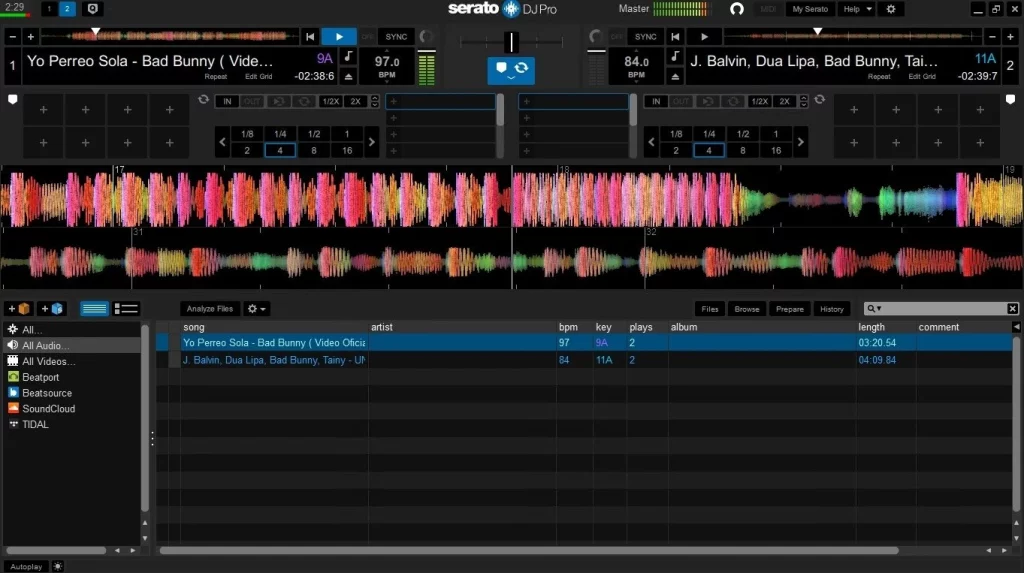Setting the Stage for Serato DJ Pro
The Digital DJ Landscape: A Quick Glance
The world of DJing has experienced a seismic shift over the past decade. From the nostalgic days of vinyl to the digital age’s CDJs and controllers, there has always been an innate need for tools that make a DJ’s job easier and more expressive. Enter the world of DJ software, a market dominated by powerhouses like Serato DJ Pro, Traktor Pro, and Pioneer’s Rekordbox.
Serato DJ Pro, birthed from New Zealand, quickly found its footing as a favorite among scratch DJs, especially with its integration with hardware like Rane mixers. But how does it truly stand up in the crowded world of DJ software? Let’s delve in.
My First Spin with Serato
I still remember the first time I launched Serato. The clean, intuitive interface greeted me, a stark difference from the cluttered software I had used previously. The waveforms, a visual representation of the track, were clear and crisp. Instantly, I felt the blend of functionality with user-friendliness. But as with every software, there’s a learning curve, and Serato was no exception. Yet, as I dove deeper, I started to appreciate the nuanced features and tools tucked away beneath its polished exterior.

Serato’s Symphony – How It Fares Against the Competition
Serato DJ Pro vs. The World
Let’s get one thing straight; when you’re talking about the big leagues of DJ software, you’re essentially nitpicking at the zenith of perfection. However, nuances do exist.
- Serato DJ Pro vs. Traktor Pro
Traktor, by Native Instruments, is often hailed for its advanced features and robust looping options. While Serato is intuitive, Traktor’s more modular approach gives it an edge for DJs who like to customize their workflow. But Traktor’s interface, for some, can seem a tad too complex. Serato, on the other hand, has a more approachable interface. - Serato DJ Pro vs. Rekordbox
Rekordbox, Pioneer’s foray into the software realm, integrates seamlessly with their hardware. Its biggest advantage is its compatibility with Pioneer club setups, meaning DJs can prep at home and plug and play in the club. However, where Rekordbox shines in hardware integration, Serato edges out with its expansive plugin ecosystem.
The Mix isn’t Perfect: Serato’s Shortcomings
For all its bells and whistles, Serato has its quirks. The need for specific hardware to unlock its full potential might turn away the casual user or a beginner. While the library management is robust, it isn’t as intuitive as one would hope. Additionally, while its plugin system is expansive, it comes at an extra cost, making it a potentially expensive affair.
For Whom Does the Beat Drop?
Serato DJ Pro is like that high-end sports car: perfect for those who know how to handle it but might be overkill for a newbie. Professionals, especially turntablists and scratch DJs, will appreciate its tight integration with specific hardware and its impressive FX suite. Hobbyists and bedroom DJs might find the software a bit on the pricier side, especially with added plugins. For them, a more all-inclusive package like Rekordbox might be a better fit.

Tuning Into Serato’s Technical Symphony
System Requirements for Serato DJ Pro
- Operating System: Windows 10 (64 bit) or macOS High Sierra 10.13 – macOS Monterey 12.
- Processor: Intel Core i3, i5, or i7 series (1.07 GHz or better).
- RAM: 4 GB minimum (8 GB recommended).
- Graphics: Dedicated graphics card with at least 384 MB VRAM.
- USB: USB 2.0 port.
- Display: Screen resolution of 1280 x 720 or higher.
- Hard Disk: 5 GB of free space.
- Connectivity: Internet connection for software activation.
Reflections on Serato’s Influence Peering into the horizon, it’s undeniable: Serato DJ Pro has sculpted the way DJs interact with music in the digital age. From its robust suite of features to its integration with top-tier hardware, Serato has positioned itself as a forerunner in the digital DJ scene. Its ripple effect in the industry can be seen as more and more software ventures prioritize user experience alongside deep functionality.
Yet, Serato’s influence isn’t just about tech specs. It’s about cultivating a community, fostering creativity, and driving a whole generation of DJs to push the boundaries of what’s possible musically.
A Personal Note to You, The Reader When I first ventured into the realm of DJing, it was a cacophony of options, choices, and pathways. Amidst this, Serato DJ Pro stood out as a beacon. Yes, it’s not perfect, and yes, depending on your needs, another software might resonate more. But for those seeking a blend of intuitive design with powerhouse features, Serato often feels just right.

Encore: The Final Note on Serato DJ Pro
In a world awash with beats, rhythms, and melodies, Serato DJ Pro emerges as a maestro, orchestrating the dance between DJ and audience. Its strengths, from the vibrant waveforms to its stellar plugin ecosystem, make it a go-to for many in the industry. Yet, it’s essential to recognize where it might fall short, especially for the hobbyist or those on a tight budget.
To conclude, Serato DJ Pro is more than just software; it’s a movement, an experience, a journey. Whether it’s your software of choice or merely a pit-stop in your DJing voyage, it’s undeniable that Serato has left an indelible mark on the DJing world. So, to those exploring this realm, my advice? Give Serato a spin. You might just find your rhythm within its digital grooves.
